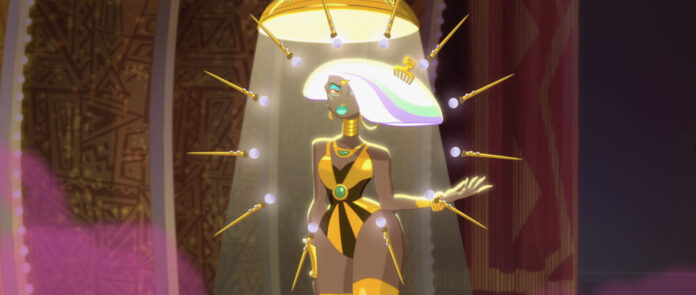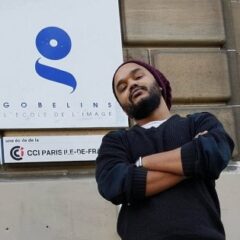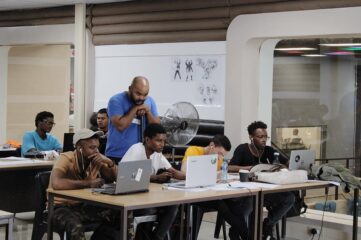We recently had the chance to catch up with Lesego Vorster, co-founder of Johannesburg-based The Hidden Hand Studios, who wrote and directed the high-profile You Give Me Heart short in the acclaimed Disney+ Afro-futurist anthology series Kizazi Moto: Generation Fire. The talented animation director was kind enough to discuss his recent projects and his animation education at Gobelins and offer some helpful advice for young animation students who would like to spread their wings across the various sectors of the field worldwide:
Animation Magazine: Congrats on all your recent achievements, Lesego. Can you tell us a bit about your background in animation?
Lesego Vorster: Well, as a young boy, I had always inherently known that animation had to do with drawing of some kind, but my endless questions to my poor mother heeded no results whatsoever. But also credit to her, she used to get me any book, VHS tape or comic strip she could because she knew my love for drawing. One such tape was Disney’s Tarzan, which I watched on repeat, always rewinding it, for about two years. Until one day I was too enthralled in my drawing and let it play on …something magical happened, a short Making Of excerpt started playing showing Glen Keane working in Paris with his Tarzan team — my mind was blown and I knew that I wanted my drawings to move like that some day.
Alas, it was only much later, during my university days while studying Fine Arts that I started gathering bits of knowledge from the Digital Arts teacher and touched my first Wacom. I knew then that I would be an animator of some sort in the near future as, suddenly, I had access to the equipment and software to accomplish my dream. It goes without saying that very soon followed a lot of frustration as I did not know the principles of animation, nor simple fundamentals such as the bouncing ball. I then began being intentional with my animation work, working over-night after school to practice and get better at the craft.
Did you always want to work in animation?
Absolutely. Being afforded the honor of working in this field constantly feels like a gift to little Lesego, and I bow down to his wisdom because it really feels like being employed to work on my hobby at times.
How did your studies at the world-famous French animation school Gobelins prepare you for your future career in animation?
Gobelins taught me three important lessons:
- You can only be as good as your desire to improve. There is no red pill in this here Matrix. Those guys and gals work their butts off … It is when I started working on focused learning that I started seeing improvement in my work.
- There is always someone younger, faster and better. So I had to ask myself, “What am I offering to this beloved industry of mine if people are going to be so darn good at this?” I found my answer and it brought me eternal peace, this doesn’t mean I stopped pushing myself, au contraire, I knew then and know now that all this is a skill, not a talent. One can work on something with intention and improve. It’s as simple as that, you get out what you put in. Great analogy for life, isn’t it? Of course different people have different aptitudes, but diligence has failed me yet, nor has it failed any of my peers whom I respect.
- When I went to study at Gobelins in Paris, I was coming from being an animation lecturer in South Africa, and I had a keener sense of learning than most as I was now on the other side of the fence and saw the importance of accountability. I mean, I had always known it, but I had never lived it, what with my higher-than-thou tower just judging and failing students left and right. I kid of course, but the flip from teacher to student made me an even better teacher with a heightened sense of empathy for those I would lead in future.
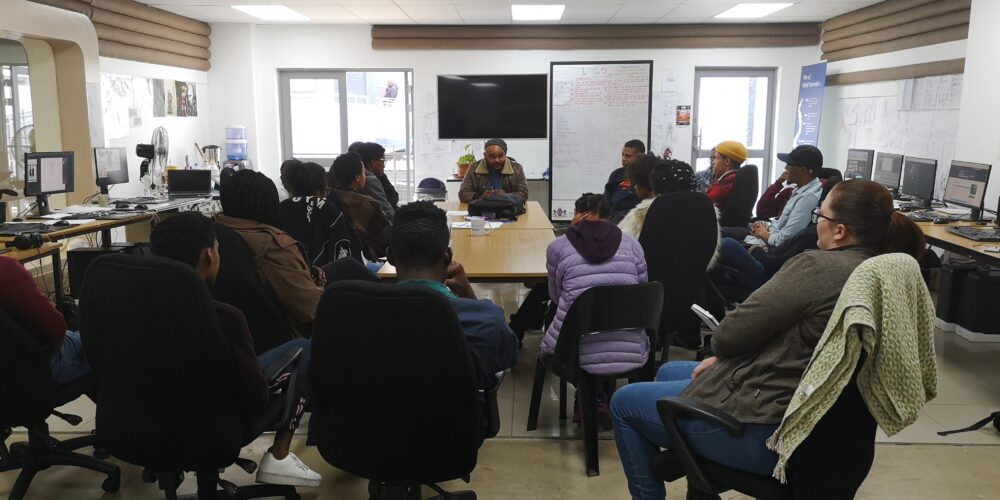
Can you tell us a bit about how and why you formed The Hidden Hand Studios in South Africa?
The Hidden Hand Studios was a dream, like many young artists have, of starting a studio that does cool stuff. It is only later when myself and my partner, Ross Lelliott, really leaned into affording ourselves the chance to push our work that we realized that the reason we could not fail was that the stories we wanted to tell and the characters we know intimately from our backgrounds were not going to be represented on screen. And rightfully so — because if not us, then who? Who would take themselves out of their own raison d’être to accomplish ours? The cross is ours to bear, and now we believe we are on the way to creating our stories with characters which one of the biggest continents can identify with and relate to and, maybe most importantly to our child-selves, in a really cool way.
How did you end up working on the Disney+ anthology series Kizazi Moto: Generation Fire (which premiered last July)?
All the directors received an invitation to pitch. The first few meetings and emails were quite daunting as the list of names was not only really impressive, but also really long. One could almost be forgiven for having some doubt of being selected, but I think I have managed to successfully numb the part of my brain that processes doubt and, in so doing, really believed that I had a really great story with You Give Me Heart. The folks over at Triggerfish paired me with an amazing writer, Nonzi Bogatsu, who shared a similar up-bringing to my own (we are both Soweto born and bred) and we, together, managed to make it through the multiple rounds of selections and eliminations, resulting in You Give Me Heart being part of the final 10 films selected for development and production.
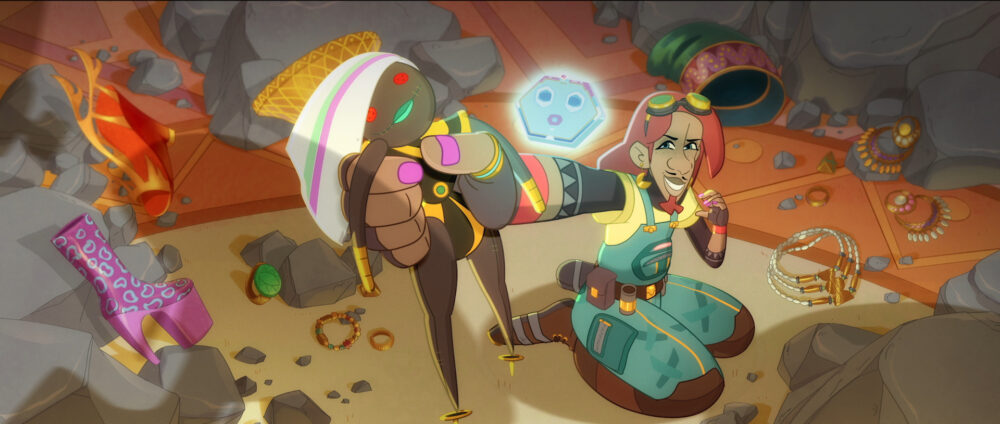
What makes that experience stand out for you?
The Disney team was really great. They were fully supportive, responsive and insisted on having the directors put the best of themselves forward. It was a really surprising experience because one would expect so much red tape, but that was not the case. Of course, the producers had the harder task of reigning us in when we went a bit too crazy, but those times were few and far in-between.
To further enhance the quality of all the films, we all had multiple sessions with the amazing Peter Ramsey [executive producer of the series] and the immovable and ever-knowledgeable Sydney Kombo, along with many other great individuals who helped in shaping our films to the best they could be. Having such experienced people made it easier to accept some hard truths, because one could be excused in believing that they are special and no-one in the world has felt the way they feel currently as the special director, but you would be surprised how many situations are just part of the process … and you should always trust the process.
What is your take on the growing animation scene in South Africa and the future of global partnerships in animation worldwide?
South Africa finds itself in the fortunate position where the world can see the great potential of the stories, artists and films coming out of here — but as a result, we find ourselves needing to upskill really fast, which is quite a herculean undertaking. Alas, these are champagne problems which the global partnerships are really remedying as we suddenly have access to the best talent and guidance in the world, leading us to take our rightful place as a part of that best talent in the not so distant future.
Furthermore, we are finding ourselves (the South African film industry) being afforded plenty of opportunities to co-produce with many experienced countries through treaties which allow for us to collaborate and encourage skills exchange on a much higher level than previously afforded.
What kind of advice can you offer young students who dream of having a fulfilling career in animation in the years to come?
Well, if you have read the entire interview up until here, I am certain you can tell that I am a mixture between a romantic and a realist. So that would be my advice: There is nothing in the world that is stronger than belief. Believe you can make the best film, believe you can be the best artist, believe that you can contribute to this field in a meaningful way and it will find a way to accommodate you. But belief without effort is just a wish, isn’t it? So the consistency and discipline of smart and hard work can never be replaced. I acutely remember when going to Gobelins was but a far-away pipe dream, I still hold the vivid memories of directing a film for Disney as impossible, and I still have sudden realizations when I am sitting in my studio and I look around to see my incredibly skilled team slowly chipping away at a project that we are all giving our best on.
Do your best and be disciplined. I have personally seen mediocre and even sub-par artists become proficient and excellent at their craft. It really is that healthy mixture of romanticism and realism that has served me well; find your own balance and eventually things will align. Your voice might be not be in vogue right now, but there will come a time where there is demand for a story, design, whatever it may be, that you have been working hard at in the periphery and then it will be your time to shine. African animation was not even a subject during some of our budding stages, yet we collectively insisted and now here we stand, multiple shows streaming, multiple TV series and many more shows in the making which will raise the bar of what can be expected from the continent.
On a parting note, coming from a long career as an animation lecturer, it could be a good idea to educate your parents in the field, because most times you find that the parents are the biggest hurdle.
Kizazi Moto: Generation Fire is now streaming on Disney+. For more information about Vorster’s studio, visit hiddenhand.co.za.




